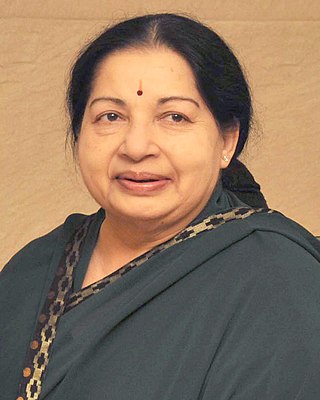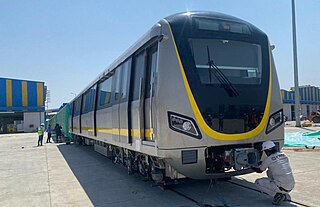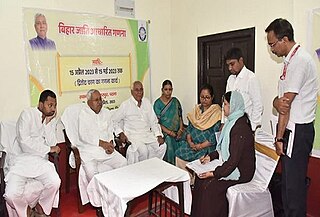
The HAL Tejas is an Indian single-engine, advanced 4th generation delta wing multirole combat aircraft designed by the Aeronautical Development Agency (ADA) and manufactured by Hindustan Aeronautics Limited (HAL) for the Indian Air Force (IAF) and Indian Navy. Tejas made its first flight in 2001 and entered into service with the IAF in 2015. In 2003, the aircraft was officially named "Tejas". Currently Tejas is the smallest and lightest in its class of supersonic combat aircraft.
The Other Backward Class (OBC) is a collective term used by the Government of India to classify castes that are educationally or socially backward. It is one of several official classifications of the population of India, along with general castes, Scheduled Castes and Scheduled Tribes (SCs and STs). The OBCs were found to comprise 52% of the country's population by the Mandal Commission report of 1980 and were determined to be 41% in 2006 when the National Sample Survey Organisation took place. There is substantial debate over the exact number of OBCs in India; it is generally estimated to be sizable, but many believe that it is higher than the figures quoted by either the Mandal Commission or the National Sample Survey.
The Mandal Commission or the Socially and Educationally Backward Classes Commission (SEBC), was established in India in 1979 by the Janata Party government under Prime Minister Morarji Desai with a mandate to "identify the socially or educationally backward classes" of India. It was headed by B. P. Mandal, an Indian member of parliament, to consider the question of reservations for people to address caste discrimination, and to use eleven social, economic, and educational indicators to determine backwardness. In 1980, based on its rationale that OBCs identified on the basis of caste, social, economic indicators made up 52% of India's population, the commission's report recommended that members of Other Backward Classes (OBC) be granted reservations to 27% of jobs under the central government and public sector undertakings, thus making the total number of reservations for SC, ST and OBC to 49.5%.
The decennialcensus of India has been conducted 15 times, as of 2011. While it has been undertaken every 10 years, beginning in 1872 under Viceroy Lord Mayo, the first complete census was taken in 1881. Post 1949, it has been conducted by the Registrar General and Census Commissioner of India under the Ministry of Home Affairs, Government of India. All the censuses since 1951 were conducted under the 1948 Census of India Act, which predates the Constitution of India. The 1948 Census of India Act does not bind the Union Government to conduct the census on a particular date or to release its data in a notified period. The last census was held in 2011, whilst the next was to be held in 2021 before it was postponed due to the COVID-19 pandemic in India. The next census will be held after the 2024 general election.
Bihari is a demonym given to the inhabitants of the Indian state of Bihar. Bihari people can be separated into three main Indo-Aryan ethnolinguistic groups, Bhojpuris, Maithils and Magadhis. They are also further divided into a variety of hereditary caste groups. In Bihar today, the Bihari identity is seen as secondary to caste/clan, linguistic and religious identity but nonetheless is a subset of the larger Indian identity. Biharis can be found throughout India, and in the neighbouring countries of Nepal, Pakistan and Bangladesh. During the Partition of India in 1947, many Bihari Muslims migrated to East Bengal. Bihari people are also well represented in the Muhajir people of Pakistan because of Partition.
Reservation is a system of affirmative action in India created during the British rule. It provides historically disadvantaged groups representation in education, employment, government schemes, scholarships and politics. Based on provisions in the Indian Constitution, it allows the Union Government and the States and Territories of India to set reserved quotas or seats, at particular percentage in Education Admissions, Employments, Political Bodies, Promotions, etc., for "socially and educationally backward citizens."
Nasiyanur is a panchayat town located adjoining the city of Erode in Erode district in the Indian state of Tamil Nadu. It is located on National Highway NH 544 between Perundurai and Chithode. As a panchayat town, Nasiyanur is in a state of transition from rural to urban.
At the 2011 Census, Bihar was the third most populous state of India with total population of 104,099,452, nearly 89% of it is rural. It was also India's most densely populated state, with 1,106 persons per square kilometre. The sex ratio was 918 females per 1000 males. Almost 58% of Bihar's population was below 25 years age, which is the highest in India. At 11.3%, Bihar has the second-lowest urbanisation rate in India after Himachal Pradesh.
The demographics of Uttar Pradesh is a complex topic, which is undergoing dynamic change. Uttar Pradesh is India's most populous state, and the largest subdivision in the world. It has a population of about 199,812,341 as per the 2011 census. If it were a separate country, Uttar Pradesh would be the world's fifth most populous nation, next only to China, India, the United States of America and Indonesia. Uttar Pradesh has a population more than that of Pakistan. There is an average population density of 828 persons per km² i.e. 2,146 per sq mi. The capital of Uttar Pradesh is Lucknow, and Prayagraj serves as the state’s judicial capital. Hindus and Muslims both consider the state as a holy place.
Punjab is home to 2.3% of India's population; with a density of 551 persons per km2. According to the provisional results of the 2011 national census, Punjab has a population of 27,743,338, making it the 16th most populated state in India. Of which male and female are 14,639,465 and 13,103,873 respectively. 32% of Punjab's population consists of Dalits. In the state, the rate of population growth is 13.9% (2011), lower than national average. Out of total population, 37.5% people live in urban regions. The total figure of population living in urban areas is 10,399,146 of which 5,545,989 are males and while remaining 4,853,157 are females. The urban population in the last 10 years has increased by 37.5%. According to the 2011 Census of India, Punjab, India has a population of around 27.7 million.

The 2011 census of India or the 15th Indian census was conducted in two phases, house listing and population enumeration. The House listing phase began on 1 April 2010 and involved the collection of information about all buildings. Information for National Population Register (NPR) was also collected in the first phase, which will be used to issue a 12-digit unique identification number to all registered Indian residents by Unique Identification Authority of India. The second population enumeration phase was conducted between 9 and 28 February 2011. Census has been conducted in India since 1872 and 2011 marks the first time biometric information was collected. According to the provisional reports released on 31 March 2011, the Indian population increased to 1.21 billion with a decadal growth of 17.70%. Adult literacy rate increased to 74.04% with a decadal growth of 9.21%. The motto of the census was Our Census, Our Future.
Koppula Velama or Koppu Velama is a Telugu farmer caste found in Andhra Pradesh, India. They are primarily found in the Uttarandhra region with smaller populations in other districts of the state. They are classified under the Other Backward Classes (OBCs) by the Government of Andhra Pradesh. They are politically well-represented in the Uttarandhra region. Koppula Velama is similar to Velama caste.
The Socio Economic and Caste Census 2011 (SECC) was conducted for the 2011 Census of India. The Manmohan Singh government approved the Socio Economic and Caste Census 2011 to be carried out after discussion in both houses of Parliament in 2010. SECC-2011 was not done under the 1948 Census of India Act and the Registrar General and Census Commissioner of India was not entrusted to do the same. The SECC 2011 was conducted in all states and union territories of India and the first findings were revealed on 3 July 2015 by Union Finance Minister Arun Jaitley. SECC 2011 is also the first paperless census in India conducted on hand-held electronic devices by the government in 640 districts. The rural development ministry has taken a decision to use the SECC data in all its programmes such as MGNREGA, National Food Security Act, and the Deen Dayal Upadhyaya Grameen Kaushalya Yojana. SECC 2011 was the first caste-based census since 1931 Census of India, and it was launched on 29 June 2011 from the Sankhola village of Hazemara block in West Tripura district.

The Fifteenth Legislative Assembly Election was held on 16 May 2016 for the 232 seats of the Legislative Assembly in the state of Tamil Nadu in India. The AIADMK under J. Jayalalithaa won the elections and became the first ruling party to be re-elected in Tamil Nadu since 1984, though with a simple majority. The DMK won half of the seats it contested but its allies performed poorly; notably, the Indian National Congress won 16% of the seats they contested, and the alliance lost due to its poor performance. The votes were counted on 19 May 2016. In the previous election in 2011, AIADMK, under the leadership of Jayalalithaa, won a thumping majority and formed the government, while DMDK chief Vijayakanth served as the Leader of Opposition until January 2016. This was the last election that J. Jayalalithaa and M. Karunanidhi contested, as they both died in 2016 and 2018 respectively.

General elections will be held in India from 19 April 2024 to 1 June 2024 to elect the 543 members of the 18th Lok Sabha. The elections will be held in seven phases and the results will be announced on 4 June 2024. This will be the largest-ever election in the history of the world, surpassing the 2019 Indian general election, and will last 44 days, second only to the 1951–52 Indian general election. The incumbent prime minister Narendra Modi, who completed a second term, is contesting for a third consecutive term.

The Yellow Line of Namma Metro is under construction and will form part of the metro rail network for the city of Bangalore, Karnataka, India. The 18.82 km (11.69 mi) line connects R.V. Road with Bommasandra and is fully elevated with 16 stations. R.V. Road station is the terminal station on the city side where an interchange is being provided with the Green Line. Jayadeva Hospital station will serve as another elevated interchange station with the Pink Line that is also under construction in Phase ll of Namma Metro's expansion. Upon its opening, Jayadeva Station will be the tallest and largest metro station in Bengaluru, with 5 levels of transport, including the metro lines. Central Silk Board station will be another interchange station between the Yellow Line and Blue Line. The other end of the Yellow Line will terminate at Bommasandra. The line was scheduled to open in June 2023, but due to construction delays, it was scheduled around July 2024. But now as per latest reports, the Yellow Line will be operational from November 2024. This postpone has been attributed to delay in delivery of coaches from China.
The 2023 Census of Pakistan was the detailed enumeration of the Pakistani population and the seventh national census in the country. It was conducted by the Pakistan Bureau of Statistics. It was also the first ever digital census to be held in Pakistan, including the first in South Asian history.

The 2024 Bruhat Bengaluru Mahanagara Palike elections are to be held after the Indian general election in May 2024 to elect corporators for all 243 wards of the Bruhat Bengaluru Mahanagara Palike. The elections, due in 2020, have been delayed due to factors such as the COVID-19 pandemic, process of ward delimitation and lack of consensus over reservations.

The 2024 Indian general election in Bihar will be held in all 7 phases from 19 April to 1 June to elect 40 members of the 18th Lok Sabha, with the results declared on 4 June.

The 2022 Bihar Caste Based Survey was notified by the Government of Bihar on 6 June 2022 by gazette notification after a Supreme Court ruling. The survey was conducted in two phases, house listing and caste and economic enumeration. The data collection for the survey began on 7 January 2023 and the data was released on 2 October 2023. The responsibility to conduct the survey was given to the General Administration Department (GAD) of the Government of Bihar. The government planned to collect the data digitally by mobile application named Bijaga- Bihar Jaati Adharit Ganana. BELTRON, a Government of Bihar agency provided IT support, hired the services of a Maharashtra-based private firm Trigyn Technologies to develop the mobile app.








